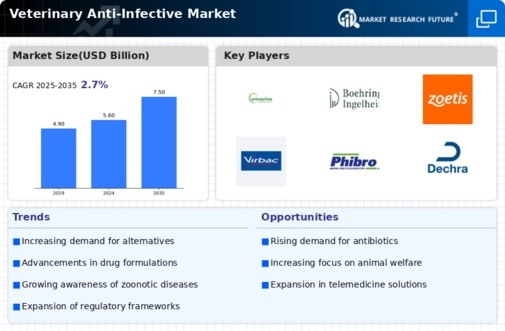Market Growth Projections
The Global Veterinary Anti-Infective Market Industry is projected to experience steady growth, with estimates indicating a market value of 5.6 USD Billion in 2024 and a potential increase to 7.5 USD Billion by 2035. This growth trajectory reflects a compound annual growth rate of 2.69% from 2025 to 2035. Such projections underscore the ongoing commitment to enhancing animal health through effective anti-infective treatments, driven by factors such as rising animal protein demand, regulatory support, and advancements in veterinary medicine. These metrics highlight the industry's resilience and adaptability in addressing the challenges of animal health.
Rising Demand for Animal Protein
The increasing global population and the corresponding rise in demand for animal protein are driving the Global Veterinary Anti-Infective Market Industry. As consumers seek high-quality meat and dairy products, livestock health becomes paramount. This trend necessitates the use of anti-infectives to prevent and treat infections in animals, ensuring optimal productivity. The market is projected to reach 5.6 USD Billion in 2024, reflecting the urgency for effective veterinary care. Furthermore, as the industry evolves, the focus on sustainable farming practices may further enhance the demand for veterinary anti-infectives, as healthy animals contribute to sustainable food production.
Global Trade and Livestock Movement
The globalization of trade and the movement of livestock across borders are significant factors influencing the Global Veterinary Anti-Infective Market Industry. As livestock is transported internationally, the risk of disease transmission increases, necessitating the use of anti-infectives to safeguard animal health. Countries are implementing stringent biosecurity measures and health certifications to mitigate these risks, further driving the demand for veterinary anti-infectives. This dynamic is expected to contribute to the market's growth trajectory, as stakeholders seek to ensure the health of animals in a globally interconnected food supply chain.
Increasing Pet Ownership and Spending
The rise in pet ownership globally, coupled with increased spending on pet healthcare, is a crucial driver for the Global Veterinary Anti-Infective Market Industry. As more households adopt pets, the demand for veterinary services, including anti-infectives, escalates. Pet owners are increasingly willing to invest in their pets' health, leading to a surge in the use of preventive and therapeutic anti-infective treatments. This trend is expected to sustain market growth, as the industry adapts to meet the evolving needs of pet owners who prioritize their pets' well-being and quality of life.
Regulatory Support for Veterinary Health
Government regulations aimed at improving animal health and welfare are significantly influencing the Global Veterinary Anti-Infective Market Industry. Regulatory bodies are increasingly mandating the use of anti-infectives to manage disease outbreaks in livestock and companion animals. This regulatory environment not only encourages the development of new veterinary drugs but also ensures that existing products meet safety and efficacy standards. As a result, the market is expected to grow steadily, with a projected value of 7.5 USD Billion by 2035. This growth is indicative of a broader commitment to animal health, which is essential for food safety and public health.
Technological Advancements in Veterinary Medicine
Innovations in veterinary medicine, particularly in diagnostics and treatment options, are propelling the Global Veterinary Anti-Infective Market Industry forward. Advanced diagnostic tools enable veterinarians to identify infections more accurately and swiftly, leading to timely interventions. Moreover, the development of novel anti-infective agents, including biologics and targeted therapies, enhances treatment efficacy. These advancements are likely to contribute to a compound annual growth rate of 2.69% from 2025 to 2035, as they improve animal health outcomes and reduce the economic burden of infectious diseases in livestock and pets.



















